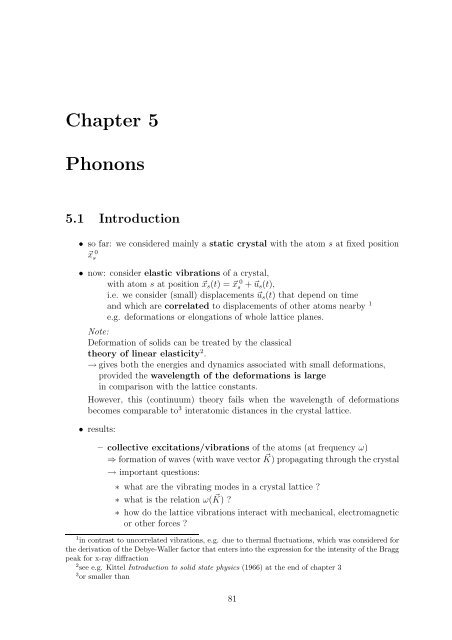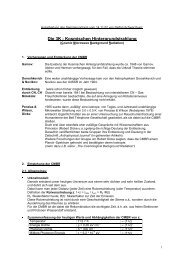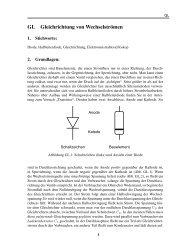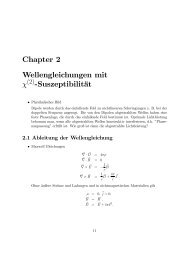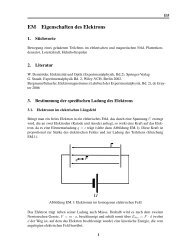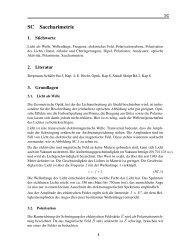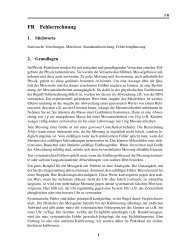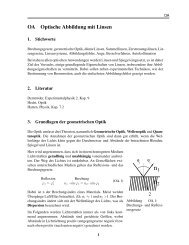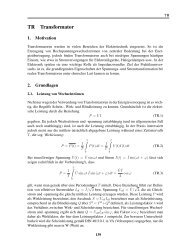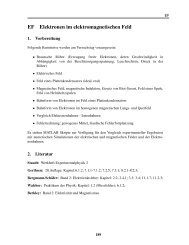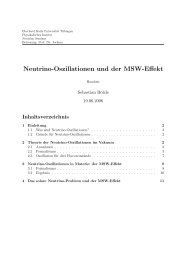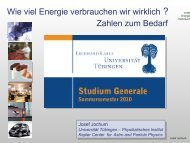You also want an ePaper? Increase the reach of your titles
YUMPU automatically turns print PDFs into web optimized ePapers that Google loves.
<strong>Chapter</strong> 5<br />
<strong>Phonons</strong><br />
5.1 Introduction<br />
• so far: we considered mainly a static crystal with the atom s at fixed position<br />
�x 0<br />
s<br />
• now: consider elastic vibrations of a crystal,<br />
with atom s at position �xs(t) = �x 0<br />
s + �us(t),<br />
i.e. we consider (small) displacements �us(t) that depend on time<br />
and which are correlated to displacements of other atoms nearby 1<br />
e.g. deformations or elongations of whole lattice planes.<br />
Note:<br />
Deformation of solids can be treated by the classical<br />
theory of linear elasticity 2 .<br />
→ gives both the energies and dynamics associated with small deformations,<br />
provided the wavelength of the deformations is large<br />
in comparison with the lattice constants.<br />
However, this (continuum) theory fails when the wavelength of deformations<br />
becomes comparable to 3 interatomic distances in the crystal lattice.<br />
• results:<br />
– collective excitations/vibrations of the atoms (at frequency ω)<br />
⇒ formation of waves (with wave vector � K) propagating through the crystal<br />
→ important questions:<br />
∗ what are the vibrating modes in a crystal lattice ?<br />
∗ what is the relation ω( � K) ?<br />
∗ how do the lattice vibrations interact with mechanical, electromagnetic<br />
or other forces ?<br />
1 in contrast to uncorrelated vibrations, e.g. due to thermal fluctuations, which was considered for<br />
the derivation of the Debye-Waller factor that enters into the expression for the intensity of the Bragg<br />
peak for x-ray diffraction<br />
2 see e.g. Kittel Introduction to solid state physics (1966) at the end of chapter 3<br />
3 or smaller than<br />
81
82 <strong>Chapter</strong> 5 <strong>Phonons</strong><br />
– lattice vibrations have particle-like character<br />
quantum mechanical treatment (particle-wave-dualism):<br />
propagating waves ↔ phonons with energy �ω (analogy to photons)<br />
– importance of phonons:<br />
∗ determine many thermodynamic properties of a crystal<br />
(e.g. specific heat)<br />
∗ contribution to thermal conductivity<br />
∗ interaction with electrons<br />
→ large contribution to resistivity in metals<br />
→ formation of (”Cooper pairs”) in (’conventional’) superconductors<br />
∗ absorption/emission of light in semiconductors<br />
∗ ...<br />
• How many modes of oscillations can exist in a crystal with N atoms?<br />
– 1 atom: 3 degrees of freedom (translation in x, y, z direction 4 )<br />
– 2 uncoupled atoms: 2×3 degrees of freedom<br />
– 2 coupled atoms: also 6 degrees of freedom:<br />
3 × translation<br />
2 × rotation (perpendicular to the line connecting the<br />
atoms)<br />
1 × oscillation<br />
– N uncoupled atoms: 3N degrees of freedom (translation)<br />
– N coupled atoms: also have to have 3N degrees of freedom:<br />
3 × translation (crystal as a whole)<br />
3 × rotation (crystal as a whole)<br />
⇒ 3N − 6 × oscillation<br />
One finds: the 3N −6 degrees of freedom for oscillations can be classified<br />
into relatively simple modes of oscillations characterized<br />
by their dependence ω( � K) (’dispersion relation’)<br />
4 neglecting rotational motion of the single atoms
5.1 Introduction 83<br />
Most simple situation is obtained in the [100], [110] and [111] propagation directions<br />
of cubic crystals (correspond to directions along the cube edge, the face diagonal and<br />
the body diagonal, respectively).<br />
If a wave is propagating along one of these directions entire planes of atoms move in<br />
phase with displacements either parallel (’longitudinal) or perpendicular (’transverse’)<br />
to the direction of the wavevector � K<br />
⇒ allows simple description of the displacement of a whole plane s from its equilibrium<br />
position<br />
⇒ 1-dimensional problem<br />
Each wavevector has three ’polarization’ modes – one longitudinal (Fig.5.1) and two<br />
transverse (Fig.5.2).<br />
Figure 5.1: (Dashed lines) Planes of atoms when in equilibrium. (Solid lines) Planes<br />
of atoms when displaced as for a longitudinal wave. The coordinate u measures the<br />
displacement of the planes [from Kittel, Introduction to solid state physics (1996);<br />
Fig.4.2].<br />
Figure 5.2: Planes of atoms as displaced during passage of a transverse wave [from<br />
Kittel, Introduction to solid state physics (1999); Fig.4.3].
84 <strong>Chapter</strong> 5 <strong>Phonons</strong><br />
5.2 1-dimensional chain of identical atoms<br />
Chain consists of N atoms with masses M.<br />
• allow only motion of atoms along x-direction<br />
→ one degree of freedom corresponds to translation of the whole chain along x<br />
⇒ N − 1 degrees of freedom for oscillations<br />
• arrangement of atoms:<br />
Figure 5.3: Displacement of atoms in 1dimensional<br />
chain<br />
Atoms located at positions xs = sa + us(t) with lattice constant a<br />
• choose for simplicity periodic boundary conditions:<br />
Atom 1 has always same position and momentum as atom N + 1<br />
(in open chain: e.g. atom 1 and atom N is fixed in space)<br />
Force acting on atom s due to atom s + 1:<br />
Fs = C(us+1 − us) , with force constant C (5.1)<br />
Fs is linear in the displacements → Hooke’s law – is valid if deflection us is not<br />
too large<br />
For simplicity we consider only interactions with nearest neighbors s + 1 and s − 1;<br />
then the total force acting on atom s is<br />
Fs = C(us+1 − us) + C(us−1 − us) (5.2)<br />
⇒ equations of motion of atoms (s = 1 . . . N) with mass M:<br />
M d2 us<br />
dt 2 ≡ Müs = C(us+1 + us−1 − 2us) (5.3)<br />
Ansatz for time dependence of displacements: us = u (0)<br />
s e −iωt<br />
⇒ üs = −ω 2 us in (5.3)<br />
⇒ −Mω 2 u 0 s = C(u 0 s+1 + u 0 s−1 − 2u 0 s) (5.4)<br />
which is a difference equation in the displacements u,<br />
with travelling wave solutions<br />
u 0 s = ue iKsa<br />
(= longitudinal wave along x with wavevector K)<br />
(5.5)<br />
with (5.5) in (5.4) ⇒ −Mω 2 ue iksa = Cu(e iK(s+1)a + e iK(s−1)a − 2e iKsa ) (5.6)<br />
(divide by u · e iKsa )
5.2 1-dimensional chain of identical atoms 85<br />
⇒ Mω 2 = −C(e iKa + e −iKa − 2) = 2C(1 − cos Ka) (5.7)<br />
This finally yields the dispersion relation ω(K)<br />
ω 2 = 2C<br />
�<br />
4C<br />
(1 − cos Ka); ω =<br />
M M<br />
for the travelling wave us = ue i(sKa−ωt) .<br />
(with 2 cos x = e i x + e −ix )<br />
� �<br />
�<br />
�<br />
Ka �<br />
�sin �<br />
2 �<br />
(5.8)<br />
(with √ 1 − cos x = | sin(x/2)|)<br />
Figure 5.4: Dispersion relation<br />
ω(K) of monatomic linear chain.<br />
• The regime of physically significant values of K is limited due to e iKa ≡ e i(Ka+2πn) ,<br />
(with n = 0, ±1, ±2, . . .)<br />
→ independent K vectors are only specified within the interval<br />
−π ≤ Ka ≤ π ⇔ − π<br />
a<br />
≤ K ≤ π<br />
a<br />
1. Brillouin zone<br />
• connection between K values within and outside the 1. Brillouin zone:<br />
A vector K outside the 1. Brillouin zone can be transformed into a vector K ′<br />
inside the 1. Brillouin zone by subtracting or adding a multiple of 2π/a,<br />
i.e. via the transformation K ′ = K + G where G is a reciprocal lattice vector.<br />
The displacement ration of neighboring atoms is<br />
us+1<br />
us<br />
= u e[i(s+1)Ka]<br />
u e isKa<br />
= eiKa<br />
hence<br />
us+1<br />
= e<br />
us<br />
iKa = e i2πn<br />
���� · e<br />
=1<br />
i(Ka−2πn) ≡ e iK′ a<br />
i.e. any displacement can always be described by a wavevector within the<br />
1. Brillouin zone.<br />
(5.9)<br />
(5.10)
86 <strong>Chapter</strong> 5 <strong>Phonons</strong><br />
In other words:<br />
The range of −π ≤ Ka ≤ π covers all independent values of the exponential<br />
e iKa = us+1/us. I.e., saying that two adjacent atoms are out of phase by 0.3π or<br />
2.3π has the same physical meaning, as shown in the figure below.<br />
Figure 5.5: The wave represented by the solid curve conveys no information not given<br />
by the dashed curve. Only wavelengths longer than 2a are needed to represent the<br />
motion [from Kittel, Introduction to solid state physics (1996); Fig.4.5].<br />
• limit of long wavelength:<br />
if K ≪ a ⇔ wavelength λ ≡ 2π/K ≫ a<br />
one can approximate in (5.8) |sin(x)| ≈ x, i.e.<br />
�<br />
C<br />
ω ≈ Ka ∝ K (5.11)<br />
M<br />
this limit corresponds to the continuum approximation<br />
• there exists a maximum value for the frequency ωmax = (4C/M) 1/2 ,<br />
reached when the K ’vector’ lies on the boundary of the 1. Brillouin zone<br />
→ Kmax = ±π/a ⇔ λmin = 2a.<br />
Typical values in solids are ωmax ∼ 10 13 Hz.<br />
Solution at Kmax = ± π<br />
a (i.e. at the zone boundary): Kmaxsa = ±sπ, hence<br />
us = u · e ±iπs e −iωt = u · (−1) s e −iωt<br />
= standing wave (due to Bragg reflection at the zone boundary)<br />
compare with Bragg condition 2d sin θ = n · λ:<br />
d = a,<br />
θ = π/2 ⇒ sin θ = 1 ⇒ 2d sin θ = 2a<br />
n = 1<br />
λ = 2π/Kmax = 2π/(π/a) = 2a ⇒ n · λ = 2a q.e.d
5.2 1-dimensional chain of identical atoms 87<br />
• group velocity:<br />
The group velocity of a wave packet is given as the slope of the dispersion curve<br />
ω(K)<br />
vg = dω<br />
or �vg = gradKω(<br />
dK<br />
� K) (5.12)<br />
(corresponds to the velocity of energy propagation in a crystal)<br />
With the dispersion relation (5.8) the group velocity is<br />
�<br />
Ca2 Ka<br />
vg = cos<br />
M 2<br />
limit of long wavelength:<br />
vg =<br />
� C<br />
M<br />
· a = const.<br />
corresponds to sound waves with long wavelength;<br />
(5.13)<br />
Figure 5.6: Group velocity vs. K, for<br />
monatomic 1-dim. chain. vg = 0 at the<br />
zone boundary, i.e. there is no transport<br />
of energy<br />
• Distribution of the N − 1 oscillatory degrees of freedom<br />
from periodic boundary conditions us = us+N<br />
⇒ e iKsa = e i[K(s+N)a+2πn]<br />
⇒ NKa = 2πn<br />
⇒ K = 2π<br />
n, n = −N/2 ≤ n ≤ N/2)<br />
Na<br />
⇒ N discrete values for K; with K = 0 corresponding to translation<br />
⇒ oscillatory degrees of freedom are being ”used up”<br />
just within the 1. Brillouin zone.
88 <strong>Chapter</strong> 5 <strong>Phonons</strong><br />
• generalization to 3D:<br />
we used Hooke’s law F = C · u which is valid in that form only in one dimension;<br />
in 3D this relation becomes more complex:<br />
– replace force by stress 5 field (’Spannungsfeld’) ↔ σ(tensor; 3×3 matrix)<br />
– replace displacement by strain field (’Dehnungsfeld’) ↔ ε (tensor; 3×3 matrix)<br />
– then: ↔ σ= ↔<br />
C ↔ e ;<br />
↔<br />
C is a tensor (4. Stufe) with 81 componentsCiklm;<br />
hereby: 21 components are independent of each other<br />
(s. Kittel, chapter 3)<br />
• derivation of force constants from experiment<br />
So far, we used the approximation of only nearest neighbor interactions, i.e. for<br />
the force on atom s from the displacement of atom s + p we only considered<br />
p = ±1.<br />
Particularly in metals the effective forces can be of quite long range, i.e. interactions<br />
of lattice planes up to 20 lattice spacings apart from each other (i.e. p = 20)<br />
can be significant.<br />
For that case one can find a generalization of the dispersion relation (5.7) to p<br />
nearest neighbors as<br />
ω 2 = 2 �<br />
Cp(1 − cos pKa)<br />
M<br />
(5.14)<br />
Solving for the interplanar force constants Cp at range pa yields<br />
Cp = − Ma<br />
2π<br />
p>0<br />
for a structure with a monatomic basis.<br />
� +π/a<br />
dK ω<br />
−π/a<br />
2 K cos pKa (5.15)<br />
The measurement of the dispersion relation hence allows the determination of<br />
the range of the interplanar forces.<br />
5 stress is defined as force per unit area
5.3 1-dimensional chain of two different atoms 89<br />
5.3 1-dimensional chain of two different atoms<br />
Atoms shall have masses M1, M2<br />
Atoms with masses M1 are displaced by us−1, us, us+1,. . .<br />
and atoms with masses M2 by vs−1, vs, vs+1,. . .<br />
Figure 5.7: 1-dimensional chain of two<br />
different atoms with displacements vs, . . .<br />
and us, . . .<br />
The force constant shall be again denoted as C, i.e. force between two (different)<br />
neighboring atoms is F = C(vs − us) (Hook’s law).<br />
⇒ equations of motion:<br />
M1üs = C · (vs + vs−1 − 2us)<br />
Ansatz:<br />
travelling waves, now with different amplitudes<br />
M2¨vs = C · (us+1 + us − 2vs) (5.16)<br />
us = u · e i(sKa−ωt)<br />
vs = v · e i(sKa−ωt)<br />
(5.17)<br />
where the lattice constant a is defined as the distance between nearest neighbors of<br />
atoms with same mass (for zero displacement).<br />
Substitution of (5.17) in (5.16) yields<br />
−ω 2 M1u = Cv[1 + e −iKa ] − 2Cu<br />
−ω 2 M2v = Cu[1 + e iKa ] − 2Cv (5.18)<br />
This system of linear equations has a solution only if the determinant of the coefficients<br />
of the unknowns u, v vanishes<br />
�<br />
�<br />
�<br />
�<br />
det �<br />
�<br />
�<br />
� = 0 (5.19)<br />
hence<br />
2C − M1ω 2 −C · [1 + e −iKa ]<br />
−C · [1 + e iKa ] 2C − M2ω 2<br />
M1M2ω 4 − 2C(M1 + M2)ω 2 + 2C 2 (1 − cos Ka) = 0 (5.20)
90 <strong>Chapter</strong> 5 <strong>Phonons</strong><br />
• solution for ka ≪ 1 :<br />
with cos Ka ≈ 1 − 1<br />
2 K2 a 2 + . . . one finds the two solutions<br />
and<br />
ω 2 �<br />
1<br />
≈ 2C<br />
ω 2 ≈<br />
M1<br />
+ 1<br />
�<br />
M2<br />
C<br />
2(M1 + M2) K2 a 2<br />
• solution at the zone boundary Kmax = ± π<br />
a :<br />
cos Ka = −1, hence<br />
ω 2 = 2C<br />
M1<br />
”optical branch” (5.21)<br />
”acoustical branch” (5.22)<br />
and ω 2 = 2C<br />
M2<br />
(5.23)<br />
The full dispersion relatione, including the discussed limiting cases is shown below for<br />
the case M1 > M2.<br />
Figure 5.8: Optical and acoustical branches of the dispersion relation for a diatomic<br />
linear lattice, showing the limiting frequencies at K = 0 and K = Kmax = π.<br />
The a<br />
lattice constant is a [from Kittel, Introduction to solid state physics (1996); Fig.4.7].
5.3 1-dimensional chain of two different atoms 91<br />
The figure below shows the atom displacements transverse to the K vector.<br />
Figure 5.9: Transverse optical<br />
and transverse acoustical waves<br />
in a diatomic linear lattice, illustrated<br />
by the particle displacements<br />
for the two modes at the<br />
same wavelength. [from Kittel,<br />
Introduction to solid state<br />
physics (1996); Fig.4.10].<br />
• For the transverse optical (TO) branch at K = 0 one finds on substitution of<br />
(5.21) in (5.18)<br />
u<br />
v<br />
= −M2<br />
M1<br />
The minus sign means that the atoms vibrate against each other.<br />
(5.24)<br />
If the two atoms have opposite charges one can excite this type of vibration by<br />
the electric field of an incident light wave ⇒ ’optical’ mode.<br />
• In the K = 0 limit of (5.21) one finds as a solution for the transverse acoustical<br />
branch v = u.<br />
This means that the atoms move together, as in long wavelength acoustical vibrations<br />
⇒ ’acoustical’ mode.<br />
• frequency gap:<br />
For certain frequencies – here for (2C/M1) 1/2 < ω < (2C/M2) 1/2 – there are no<br />
wavelike solutions.<br />
→ characteristic for polyatomic lattices<br />
Solutions for real ω yield a complex wavevector<br />
⇒ us = u · e −s|K|a · e −iωt → damping in space!<br />
Note: the 2N degrees of freedom ”fit” again into the 1. Brillouin zone.
92 <strong>Chapter</strong> 5 <strong>Phonons</strong><br />
5.4 Generalization and examples<br />
• extension to p atoms in the basis: p branches in 1D<br />
• extension to 3D:<br />
– one longitudinal (”L”) and two transverse (”T”) ’polarization’ modes<br />
E.g. for NaCl or diamond with p = 2 atoms in the primitive cell:<br />
for each of the three polarization modes (1L and 2T) one gets two branches<br />
(acoustical and optical)<br />
⇒ 2 × 3 = 6 branches<br />
The figures below show examples for germanium and KBr also with p = 2<br />
atoms per primitive cell.<br />
– p atoms in primitive cell ⇒ 3p branches:<br />
3 acoustical branches (1LA, 2TA)<br />
3p − 3 optical branches → (p − 1)LO, 2(p − 1)TO<br />
(valid for each direction � K)<br />
Figure 5.10: Phonon dispersion relations in the [111] direction: Left in germanium<br />
at 80 K. The two TA phonon branches are horizontal at the zone boundary position<br />
Kmax = 2π<br />
a · � �<br />
1 1 1 . The LO and TO branches coincide at K = 0 ; this also is a conse-<br />
2 2 2<br />
quence of the crystal symmetry of Ge. The results were obtained with neutron inelastic<br />
scattering by G. Nielsson and G. Nelin. Right in KBr at 90 K, after A.D.B. Woods<br />
et al. The extrapolation to K = 0 of the TO and LO branches are called ωT and ωL.<br />
[from Kittel, Introduction to solid state physics (1996); Fig.4.8].
5.4 Generalization and examples 93<br />
Example: Silicon<br />
Si crystallizes in the diamond lattice with p = 2 atoms per cell. The figure below shows<br />
the Brillouin zone of such a cubic crystal.<br />
Figure 5.11: Brillouin zone of cubic crystals.<br />
Some points and lines of high symmetry<br />
are drawn. Γ denotes the center<br />
(0, 0, 0), the point X is given by 2π(0,<br />
1, 0),<br />
a<br />
the point L by π(1,<br />
1, 1) and the point<br />
a<br />
K by 3π(0,<br />
1, 1) [from Bergmann-Schaefer,<br />
2a<br />
Lehrbuch der Experimentalphysik, Bd. 6<br />
Festkörperphysik (1992); Abb.1.18].<br />
Due to p = 2, silicon has 6 phonon branches which are degenerate along the lines ∆<br />
and Λ.<br />
Figure 5.12: Dispersion of phonons in Si. Shown is the phonon energy �ω, with phonon<br />
frequency ω. Γ, X, K and L denote different points and ∆, Σ and Λ different lines in<br />
the Brillouin zone, as defined in fig. 5.4. Extending the line ¯ ΓK outside the Brillouin<br />
zone one reaches a point which is equivalent to X. L and T means longitudinally<br />
and transversely polarized wave, respectively, A, acoustical wave, and O optical wave.<br />
[from Bergmann-Schaefer, Lehrbuch der Experimentalphysik, Bd. 6 Festkörperphysik<br />
(1992); Abb.1.19].
94 <strong>Chapter</strong> 5 <strong>Phonons</strong><br />
Example: Tl2Ba2CaCu2O8 (high-Tc superconductor)<br />
The figures below show the Brillouin zones of a body-centered tetragonal (bct) and a<br />
simple tetragonal (st) lattice of a complex cuprate superconductor, together with the<br />
calculated phonon dispersion relations of the bct structure.<br />
Figure 5.13: Left: Brillouin zones of the body-centered tetragonal (top) and simple<br />
tetragonal (bottom) lattices. The symmetry directions along which the dispersion<br />
curves are displayed are indicated with heavy lines. For the body-centered tetragonal<br />
lattice, X = (1, 1, 0) π<br />
a , G1<br />
�<br />
= (1, 0, 0) 1 + a2<br />
c2 �<br />
π<br />
π<br />
π<br />
, and Z = (0, 0, 2) = (2, 0, 0) . For<br />
a c a<br />
the simple tetragonale lattice, X = (1, 0, 0) π<br />
π<br />
π<br />
, M = (1, 1, 0) and Z = (0, 0, 1) . a, a, c<br />
a a c<br />
are the sides of the conventional unit cells of both lattices. Right: Phonon dispersion<br />
curves of bct Tl2CaBa2Cu2O3 (2:1:2:2:8) along symmetry directions of the bct Brillouin<br />
zone. [from Kulkarni et al., Physical Review B 43, 5451 (1991); Fig. 1 and 3].
5.5 Quantized lattice vibrations: <strong>Phonons</strong> 95<br />
5.5 Quantized lattice vibrations: <strong>Phonons</strong><br />
Quantum mechanics: Energy of a wave with frequency ω:<br />
�<br />
E = n + 1<br />
�<br />
�ω<br />
2<br />
with n: number of quantum ’particles’; n = 0, 1, 2, . . .<br />
electromagnetic (light) wave: ”Quantum particle” = Photon<br />
lattice vibrations: ”Quantum particle” = Phonon<br />
here:<br />
E = (n+ 1)�ω<br />
is the energy of an elastic mode of frequency ω when the mode is excited<br />
2<br />
to the quantum number n,<br />
i.e. the mode is occupied by n phonons.<br />
For n = 0 → E = �ω/2 = zero point energy of the mode.<br />
Occurs for both – phonon and photon – due to their equivalence to a quantum mechanical<br />
harmonic oscillator of frequency ω<br />
Phonon momentum:<br />
A phonon of wavevector � K can interact with particles as if it had a momentum �p = � � K<br />
However, a phonon does not carry a physical momentum<br />
(except for � K = 0, corresponding to the translation of a crystal as a whole)<br />
Note: � K is only defined modulo a reciprocal lattice vector � G.<br />
Explanation (in the ’particle picture’):<br />
the crystal as a whole can change its momentum by � � G during Bragg<br />
reflection (recoil);<br />
Recoil energy E recoil = (� � K) 2 /2M crystal very small, since M crystal very large<br />
• possible interactions of phonons with:<br />
– electrons, neutron, photons,. . .<br />
– other phonons (due to anharmonic terms in the elastic energy)<br />
selection rules in a crystal:<br />
govern allowed transitions between quantum states,<br />
e.g. for elastic scattering of an x-ray photon by a crystal we found<br />
� k ′ = � k + � G (5.25)<br />
where � G is a reciprocal lattice vector, � k is the wavevector of the incident photon<br />
and � k ′ is the wavevector of the scattered photon.
96 <strong>Chapter</strong> 5 <strong>Phonons</strong><br />
inelastic scattering by phonons:<br />
scattering of a photon with a phonon involved can be described by either<br />
� k ′ + � K = � k + � G (5.26)<br />
i.e. the creation (emission) of a phonon of wavevector � K or by<br />
� k ′ = � k + � K + � G (5.27)<br />
i.e. the absorption of a phonon � K during the scattering process.<br />
• interaction with neutrons:<br />
Inelastic scattering of neutrons by absorption or emission of a phonon is a widely<br />
used method for the determination of the phonon dispersion relation ω( � K)<br />
Kinematics are described by<br />
→ conservation of momentum:<br />
� kneutron + � G = � k ′ neutron ± � Kph<br />
(5.28)<br />
(”±”: creation/anihilation of a phonon)<br />
Here, � G is chosen such that � K lies in the 1. Brillouin zone.<br />
→ conservation of energy:<br />
� 2 k 2 neutron<br />
2mn<br />
= �2k ′2<br />
neutron<br />
± �ωph<br />
2mn<br />
(5.29)<br />
(”±”: creation/anihilation of a phonon)<br />
Experimental determination of ω( � K) is based on the two conservation laws (5.28),<br />
(5.29).<br />
Then in the experiment, one needs to find the energy gain or energy loss of the<br />
scattered neutrons as a function of the scattering direction � k − � k ′ .<br />
Advantage of using neutrons:<br />
→ Eneutron, λneutron are comparable to Eph, λph
5.5 Quantized lattice vibrations: <strong>Phonons</strong> 97<br />
Figure 5.14: Phonon dispersion in GaAs as obtained from neutron scattering (after<br />
Strauch and Dorner). The different points and lines on/along the wave vector axis<br />
are defined in Fig.5.11; ν is the frequency [from Bergmann-Schaefer, Lehrbuch der<br />
Experimentalphysik, Bd. 6 Festkörperphysik (1992); Abb.1.30].
98 <strong>Chapter</strong> 5 <strong>Phonons</strong><br />
5.6 Thermal properties of phonons<br />
5.6.1 contribution to the heat capacity<br />
Heat capacity is very sensitive to elementary excitations and ordering phenomena in<br />
crystals (electrons, phonons, magnetic order, spin waves, superconductivity etc.).<br />
Each phenomenon has very specific properties (e.g. T dependence)<br />
⇒ heat capacity is a well suited probe;<br />
particular advantage: detects volume properties<br />
In general one defines the heat capacity either as<br />
CV ≡ (∂U/∂T )V at constant volume or<br />
Cp ≡ (∂U/∂T )p at constant pressure;<br />
here T is the temperature and U is the energy.<br />
The phonon contribution to the heat capacity of a crystal is called the<br />
lattice heat capacity Clat.<br />
some results from quantum statistics (without proof):<br />
A system of quantum particles (e.g. vibrations) shall be characterized by energies En<br />
(n: index number)<br />
– question: What is the probability f(En) of finding a quantum particle<br />
at the energy En?<br />
– answer: depends on the nature of the particle and on temperature:<br />
– particles with semi-integer spin (e.g. 1�)<br />
= fermions,<br />
2<br />
e.g. electrons:<br />
1<br />
f(En) =<br />
e (En−µ)/kBT Fermi-Dirac distribution function<br />
+ 1<br />
(5.30)<br />
Here, µ is the(chemical potential), which has to be determined in such<br />
a way that the number of particles in the system (e.g. all electrons in the<br />
crystal) is conserved.<br />
– particles with integer spin (e.g. 0�, 1�) = bosons,<br />
e.g. photons, phonons:<br />
f(En) =<br />
1<br />
e (En−µ)/kBT − 1<br />
Bose-Einstein distribution function<br />
particular property of photons, phonons:<br />
there is no conservation of the number of particles ⇒ µ = 0<br />
classical statistics (for distinguishable particles) yields probability<br />
f ∝ e −(E−µ)/kBT<br />
(5.31)<br />
Boltzmann distribution function (5.32)
5.6 Thermal properties of phonons 99<br />
Back to the phonon heat capacity:<br />
• internal energy of a vibrating crystal:<br />
U = � � 1<br />
e�ω( � �ω(<br />
K)/kBT − 1 � K) (5.33)<br />
p<br />
� k<br />
= energy �ω( � K) multiplied by the probability to have a state occupied at this<br />
energy – and with summation over all wave vectors � K and polarization states p.<br />
• there do exist a lot of states � K<br />
⇒ � � K can be transformed into an integral � dω · D(ω),<br />
with D(ω): number of states within the frequency interval dω<br />
(= ”density of states or ”Zustandsdichte”)<br />
• determination of D(ω):<br />
– consider cube with length L, plus periodic boundary conditions<br />
→ possible vibrating states<br />
(compare to linear chain with L = Na where we found K = 2πn/Na):<br />
Kx = 0, ±2π/L, ±4π/L, . . . ; Ky, Kz analog<br />
→ 1 state per<br />
� �3 2π<br />
=<br />
L<br />
8π3<br />
V<br />
→ number of states in � K space within a sphere with radius K:<br />
NK = 4π<br />
3 K3 · V<br />
8π 3<br />
(for each polarization p)<br />
The density of states for each polarization type is hence given by<br />
D(ω) = dNK<br />
dω<br />
• next task: determine dK/dω<br />
= dNK<br />
dK<br />
· dK<br />
dω<br />
V K2 dK<br />
= ·<br />
2π2 dω<br />
(5.34)<br />
(5.35)<br />
(5.36)
100 <strong>Chapter</strong> 5 <strong>Phonons</strong><br />
→ Debye model of density of states:<br />
Assumption:<br />
The velocity of sound is taken as constant for each polarization type<br />
(like in classical elastic continuum).<br />
Gives simple dispersion relation<br />
with sound velocity vs.<br />
Hence, the density of states is given as<br />
ω = vsK (5.37)<br />
D(ω) =<br />
V ω2<br />
2π2v3 s<br />
Remark:<br />
Debye model is o.k. for acoustical phonons;<br />
at sufficiently low temperature 6 mainly those phonons are excited<br />
(energy of the optical phonons is large for all � K!)<br />
With N primitive cells in the crystal volume V :<br />
The total number of acoustic phonon modes is N<br />
(5.38)<br />
From (5.35) we know then that all N vibrating states are located within the volume<br />
(in K space)<br />
N = V<br />
8π3 4π<br />
3 K3 = V<br />
8π3 4π 3<br />
(ω/vs) (5.39)<br />
3<br />
This relation defines a maximum frequency, or ’cutoff’ frequency<br />
� 2 3 6π v<br />
ω ≡ ωD =<br />
sN<br />
V<br />
� 1<br />
3<br />
(”Debye frequency”) (5.40)<br />
With the dispersion relation one gets the corresponding cutoff wavevector<br />
KD = ωD<br />
vs<br />
� 2 6π N<br />
=<br />
V<br />
� 1<br />
3<br />
(”Debye wave vector”) (5.41)<br />
Note: ωD and KD depend only on the density N/V , which is physically reasonable.<br />
6 compare distribution function
5.6 Thermal properties of phonons 101<br />
Thermal energy for each polarization type:<br />
Now we can use the obtained density of state to make the transformation from the<br />
summation over all K vectors in (5.33) to the integration over all possible frequencies<br />
up to the maximum frequency ωD<br />
�<br />
U =<br />
�ω<br />
dωD(ω)<br />
e�ω/kBT =<br />
− 1<br />
If vs is identical for all three polarizations<br />
⇒ U = 3 ·<br />
with x ≡ �ω<br />
kBT and<br />
V �<br />
2π 2 v 3 s<br />
� ωD<br />
0<br />
dω ·<br />
ω 3<br />
� ωD<br />
0<br />
dω ·<br />
e �ω/kBT − 1 = 3V k4 B<br />
xD ≡ �ωD<br />
kBT<br />
≡ Θ<br />
T<br />
V ω2<br />
2π2v3 s<br />
4 T<br />
2π2v3 s�3 ·<br />
� xD<br />
Here we defined Θ = �ωD/kB as the ”Debye temperature”<br />
Θ = �vs<br />
kB<br />
� 6π 2 N<br />
V<br />
� 1<br />
3<br />
With this definition we can express the thermal energy as<br />
U = 9NkBT<br />
� �3 � xD T<br />
dx<br />
Θ 0<br />
x3<br />
ex − 1<br />
0<br />
�ω<br />
e �ω/kBT − 1<br />
dx x3<br />
e x − 1<br />
with N atoms in the specimen. Thus, the heat capacity (plotted in Fig.5.15)) is<br />
Cv = ∂U<br />
∂T<br />
= 9NkB<br />
� �3 � xD T<br />
dx<br />
Θ 0<br />
x4ex (ex − 1) 2<br />
(5.42)<br />
(5.43)<br />
(5.44)<br />
(5.45)<br />
(5.46)<br />
(5.47)<br />
Figure 5.15: Heat capacity CV of a solid, according to the Debye approximation. [from<br />
Kittel, Introduction to solid state physics (1996); Fig.5.7].
102 <strong>Chapter</strong> 5 <strong>Phonons</strong><br />
For low temperature: xD → ∞<br />
(Debye approximation is anyway only a good approximation at low temperature)<br />
Then: � xD<br />
0<br />
dx x3<br />
e x − 1 →<br />
� ∞<br />
0<br />
dx x3<br />
e x − 1<br />
U = 3π4NkBT 4<br />
5Θ3 and cv = 12π4NkBT 3<br />
5Θ3 cV ∝ T 3<br />
= π4<br />
15<br />
≈ 234NkB<br />
� �3 T<br />
Θ<br />
(5.48)<br />
(5.49)<br />
(Debye’s T 3 law) (5.50)<br />
’simple’ explanation:<br />
We have 3N possible modes (N: number of primitive cells).<br />
Only those modes having �ω < kBT will be excited at low temperature to an energy<br />
close to kBT .<br />
Hence, from the available volume in � K space only a fraction (ωT /ωD) 3 = (T/Θ) 3 will<br />
be occupied by excited modes.<br />
�3; ⇒ number of excited phonons ≈ 3N � T<br />
Θ<br />
each phonon has energy kBT<br />
⇒ energy ∼ 3NkBT (T/Θ) 3 , and CV ∼ 12NkB(T/Θ) 3<br />
The range of validity of the T 3 is below 0.1Θ.<br />
For T ≫ Θ the heat capacity approaches the classical value 3NkB.<br />
Typical values for Θ:<br />
Li : 334 K<br />
C : 2230 K<br />
Au : 165 K<br />
K : 91 K<br />
Figure 5.16: Heat capacity of silicon and germanium. Not the decrease at low temperatures.<br />
To convert a value in cal/mol·K to J/Mol·K, multiply by 4.186. [from Kittel,<br />
Introduction to solid state physics (1996); Fig.5.8].
5.6 Thermal properties of phonons 103<br />
Einstein model of the density of states:<br />
consider N oscillators at the same frequency ω0<br />
(o.k. for many optical phonons)<br />
Density of states:<br />
Thermal energy:<br />
heat capacity:<br />
�ω0<br />
U = 3N<br />
e�ω0/kBT − 1<br />
as plotted in the figure below<br />
Cv = 3NkB<br />
D(ω) = Nδ(ω − ω0) (5.51)<br />
� �2 �ω0<br />
kBT<br />
”3” due to polarization (5.52)<br />
e �ω0/kBT<br />
(e �ω0/kBT − 1) 2<br />
(5.53)<br />
Figure 5.17: Comparison of experimental values of the heat capacity of diamond with<br />
values calculated on the earliest quantum (Einstein) model, using the characteristic<br />
temperature ΘE = �ω/kB = 1320 K. To convert to J/Mol·K, multiply by 4.186. [from<br />
Kittel, Introduction to solid state physics (1996); Fig.5.11].<br />
For low temperature: Cv ∝ e −�ω0/kBT<br />
(not as good as Debye model which is in better agreement with experimental data)<br />
For high temperature: Cv → 3NkB<br />
(reproducing the ”Dulong-Petit value”, as the Debye model does)
104 <strong>Chapter</strong> 5 <strong>Phonons</strong><br />
General expression for the density of states:<br />
A general expression for D(ω) – the number of states per unit frequency range – requires<br />
the knowledge of the phonon dispersion relation ω( � K).<br />
The number of allowed K values for which the phonon frequency is between ω and<br />
ω + dω is<br />
D(ω)dω = V<br />
8π3 �<br />
d 3 K (5.54)<br />
(We found earlier that we have one state per V/(8π 3 );<br />
The integral goes over the volume of the shell in � K space bounded by the two surfaces<br />
on which the phonon frequency is constant and either ω or ω + dω)<br />
Problem:<br />
evaluate the volume of this shell !<br />
We consider a surface of constant ω in � K space as shown in the figure below.<br />
Here, we denote dSω an element area on this surface<br />
shell<br />
Figure 5.18: Element of area dSω on a<br />
constant frequency surface in K space.<br />
The volume between two surfaces of constant<br />
frequency at ω and ω + dω is<br />
equal to � dSωdω/|∇Kω| [from Kittel, Introduction<br />
to solid state physics (1996);<br />
Fig.5.12].<br />
With the perpendicular distance dK⊥ between the surfaces of constant ω and constant<br />
ω + dω (see next figure) one gets:<br />
�<br />
d 3 �<br />
k = dSωdk⊥<br />
(5.55)<br />
shell
5.6 Thermal properties of phonons 105<br />
Figure 5.19: The quantity dK⊥ is the perpendicular<br />
distance between two constant frequency surfaces in<br />
K space, one at frequency ω, the other at frequency<br />
ω + dω [from Kittel, Introduction to solid state physics<br />
(1996); Fig.5.13].<br />
furthermore | � ∇ � K ω|dK⊥ = dω; here � ∇ � K is the gradient in K space<br />
Note:<br />
dω<br />
⇒ dSωdK⊥ = dSω<br />
| � ∇K� ω|<br />
⇒ D(ω) = V<br />
8π3 �<br />
dSω<br />
vg<br />
ω=const.<br />
• Integral goes over area of constant ω in � K space<br />
dω<br />
= dSω<br />
vg<br />
• D(ω) can contain singularity points = ”Van-Hove singularities”,<br />
if the group velocity vg = 0<br />
(this is e.g. the case at Brillouin zone boundary)<br />
Figure 5.20: Density of states as a function of frequency for (a) a solid according to<br />
the Debye model and (b) an actual crystal structure. The spectrum for the crystal<br />
starts as ω 2 for small ω, but discontinuities develop at singular points [from Kittel,<br />
Introduction to solid state physics (1996); Fig.5.14].
106 <strong>Chapter</strong> 5 <strong>Phonons</strong><br />
5.6.2 Thermal expansion of solids<br />
So far, we only considered a linear force-displacement relation to describe lattice vibrations<br />
(Hook’s law).<br />
This leads to a potential energy which is quadratic in the interatomic displacements<br />
(harmonic theory).<br />
As one of its consequences there should be no thermal expansion which we will consider<br />
now:<br />
Naive view: solid expands, while atoms oscillate<br />
about their equilibrium position.<br />
but: if one considers only harmonic oscillations, the average position of<br />
the atom remains unchanged, no matter how large the amplitude<br />
of oscillation is.<br />
⇒ thermal expansion of solids results from anharmonic potential<br />
Quantitatively:<br />
• Taylor expansion of the potential energy of an atom in the crystal potential<br />
(equilibrium position shall be at x = 0)<br />
(consider 1-dim. solid)<br />
– only 1. term: ”harmonic approximation”<br />
– additional terms: ”anharmonic”<br />
U(x) = cx 2 − gx 3 − fx 4 . . . (5.56)<br />
∗ term −gx 3 : Asymmetry in mutual repulsion of neighboring atoms<br />
∗ term −fx 4 : Softening of the vibrations (attenuation of the ”spring constant”<br />
at large amplitudes<br />
• average displacement of the atom:<br />
with β = 1<br />
bility to 1.<br />
– use Boltzmann distribution which weights all possible values of displacement<br />
x with the factor e −U(x)/kBT (classical statistics o.k. for high temperatures)<br />
kBT<br />
⇒ 〈x〉 =<br />
� ∞<br />
−∞ � ∞<br />
−∞<br />
dx · x · e −βU(x)<br />
dx · e −βU(x)<br />
(5.57)<br />
. The denominator is a normalization factor; normalizes the total proba
5.6 Thermal properties of phonons 107<br />
– expand the integrands for small displacements<br />
i.e. such that the anharmonic terms in the energy are small as compared to kBT<br />
�<br />
dx · xe −βU(x) �<br />
≈ dx · e −βcx2<br />
(x + βgx 4 + βfx 5 ) = 3√π g<br />
β−3/2<br />
4 c5/2 �<br />
dx · e −βU(x) �<br />
≈ dxe −βcx2<br />
�<br />
π<br />
=<br />
βc<br />
〈x〉 ≈ 3g<br />
2c 2 kBT (5.58)<br />
⇒ thermal expansion proportional to T due to 3. order term in the potential<br />
Measurements of the lattice constant a vs. temperature of solid argon are shown below.<br />
The slope da/dT is proportional to the thermal expansion coefficient (vanishes at low<br />
T ), which is significant at high T .<br />
Figure 5.21: Lattice constant of solid argon as a function of temperature [from Kittel,<br />
Introduction to solid state physics (1996); Fig.5.15].
108 <strong>Chapter</strong> 5 <strong>Phonons</strong><br />
5.6.3 Phonon contribution to thermal conductivity<br />
consider long slab with temperature gradient dT/dx<br />
⇒ there is a steady-state flow of heat<br />
jU = −KU · dT<br />
dx<br />
(5.59)<br />
here KU is the thermal conductivity coefficient (’Wärmeleitzahl’), and jU is the flux of<br />
thermal energy (or the energy transmitted across unit area per time)<br />
requires:<br />
transfer of thermal energy is a diffusive process, subject to random scattering processes<br />
inside the slab;<br />
otherwise jU would only be determined by the temperature difference ∆T at the ends<br />
of the slab.<br />
⇒ the random nature of the heat transfer is responsible for<br />
(i) the development of a thermal gradient, and<br />
(ii) for the appearance of a mean free path ℓ in the expression of the thermal flux.<br />
Idea for calculation: consider phonons as a gas of particles<br />
general result of the kinetic gas theory: KU = 1<br />
3<br />
Cvℓ with:<br />
C: heat capacity per volume<br />
v: mean particle velocity (here: velocity of sound, few km/s)<br />
ℓ: mean free path (typically a few nm at 300 K; a few 10 nm at 77 K)<br />
’Derivation’:<br />
consider flux of particles n〈vx〉 along x direction (n: density of particles)<br />
The associated thermal flux is then given by<br />
ju = −n〈vx〉∆U<br />
this is due to the fact that a particle will give up energy ∆U = c∆T at temperature T :<br />
(if particle comes from a region with higher temperature T + ∆T ;<br />
c: heat capacity of the particle)<br />
between end points of a mean free path ℓ:<br />
with ℓ = vτ and C = nc<br />
∆T = dT dT<br />
ℓ =<br />
dx dx 〈vx〉τ with τ: mean collision time (5.60)<br />
⇒ ju = −n〈v 2 x〉cτ dT<br />
dx<br />
jU = − 1<br />
3 Cvl<br />
dT<br />
� �� � dx<br />
=KU<br />
= −1<br />
3 n〈v2 〉cτ dT<br />
dx<br />
(5.61)<br />
(q.e.d.) (5.62)
5.6 Thermal properties of phonons 109<br />
Discussion of heat transport mediated by phonon gas<br />
Above, we introduced the mean free path for phonon scattering to derive the heat<br />
transport mediated by phonons.<br />
→ required: inelastic scattering processes, which restore thermal equilibrium.<br />
→ collisions of phonons with lattice defects, or with surface:<br />
does not work, because elastic – the phonon frequency remains unchanged<br />
→ collisions between phonons:<br />
(note: in this case anharmonic terms in the potential energy U(x) of the<br />
atoms are important!)<br />
in general: � K1 + � K2 = � K3 + � G<br />
for � G = 0: Normal processes (N processes)<br />
for � G �= 0: Umklapp-Processes (U processes)<br />
N processes:<br />
The total phonon momentum is � J = � � J n � K � � K;<br />
here n � K is the number of phonons with wavevector � K.<br />
The change in total phonon momentum is<br />
∆ � J = � J ′ − � J = � � K3 − � � K1 − � � K2 = �( � K3 − � K1 − � K2) = 0 (5.63)<br />
i.e. for N processes the total phonon momentum is conserved<br />
A distribution of hot phonons with � J �= 0 propagating down a rod will leave � J<br />
unchanged, i.e. N processes will not be able to establish thermal equilibrium.<br />
⇒ no thermal resistance, as illustrated in Fig.5.23(top) for the flow of hot gas<br />
molecules in a tube with frictionless walls and in Fig.5.24(top).<br />
U processes:<br />
⇒ U processes are responsible for the thermal conductivity due to phonons<br />
as they allow change of the total phonon momentum (Fig.5.23(bottom),<br />
5.24(bottom))<br />
Figure 5.22: (a) Normal (N)<br />
and (b) Umklapp (U) phonon<br />
collision processes in the reciprocal<br />
lattice of a 2-dim. square<br />
lattice. The square represents<br />
the 1. Brillouin zone [from Kittel,<br />
Introduction to solid state<br />
physics (1999); Fig.5.17c].
110 <strong>Chapter</strong> 5 <strong>Phonons</strong><br />
Figure 5.23: (top) Flow of gas molecules in a state of drifting equilibrium down a long<br />
open tube with frictionless walls. Elastic collision processes among the gas molecules do<br />
not change the momentum or energy flux of the gas because in each collision the velocity<br />
of the center of mass of the colliding particles and their energy remain unchanged.<br />
Thus energy is transported from left to right without being driven by a temperature<br />
gradient. Therefore the thermal resistivity is zero and the thermal conductivity is<br />
infinite. (bottom) The usual definition of thermal conductivity in a gas refers to<br />
a situation where no mass flow is permitted. Here the tube is closed at both ends,<br />
preventing the escape or entrance of molecules. With a temperature gradient the<br />
colliding pairs with above-average center of mass velocities will tend to be directed to<br />
the right, those with below-average velocities will tend to be directed to the left. A<br />
slight concentration gradient, high on the right, will be set up to enable the net mass<br />
transport to be zero while allowing a net energy transport from the hot to the cold<br />
end. [from Kittel, Introduction to solid state physics (1999); Fig.5.16a].
5.6 Thermal properties of phonons 111<br />
Figure 5.24: top: In a crystal we may arrange to create phonons chiefly at one end,<br />
as by illuminating the left end with a lamp. From that end there will be a net flux<br />
of phonons toward the right end of the crystal. If only N processes (K1 + K2 = K3)<br />
occur, the phonon flux is unchanged in momentum on collision and some phonon flux<br />
will persist down the length of the crystal. On arrival of phonons at the right end we<br />
can arrange in principle to convert most of their energy to radiation, thereby creating a<br />
sink for the phonons. Just as in Fig.5.23(top) the thermal resistivity is zero. bottom:<br />
In U processes there is a large net change in phonon momentum in each collision event.<br />
An initial net phonon flux will rapidly decay as we move to the right. The ends may act<br />
as sources and sinks. Net energy transport under a temperature gradient occurs as in<br />
Fig.5.23(bottom) [after Kittel, Introduction to solid state physics (1999); Fig.5.16cd].<br />
→ very high temperatures T > Θ:<br />
– all phonon modes are excited and the phonon density n ∝ T (compare with<br />
Bose-Einstein statistics)<br />
U processes will provide relaxation to thermal equilibrium<br />
– mean free path ℓ ∝ 1/n ∝ 1/T ⇒ KU ∝ 1/T<br />
→ low temperatures:<br />
– number of phonons which are suited to U processes decreases ∝ e −Θ/T<br />
– ⇒ K ∝ e Θ/T<br />
→ very low temperatures:<br />
– mean free paths reaches dimension of the crystal D<br />
⇒ KU → 1<br />
3 CvD ∝ T 3 , since C ∝ T 3
112 <strong>Chapter</strong> 5 <strong>Phonons</strong><br />
example (NaF):<br />
Figure 5.25: Thermal conductivity of a highly purified crystal of sodium fluoride (NaF),<br />
after H.E. Jackson, C.T. Walker and T.F. McNelly [from Kittel, Introduction to solid<br />
state physics (1999); Fig.5.18].<br />
Final remarks:<br />
• in metals:<br />
additional (strong) heat transport due to electrons<br />
• some insulators (e.g. sapphire, Al2O3):<br />
have nevertheless a thermal conductivity which is comparable to metals,<br />
e.g. maximum ∼200 W/(cmK) at 30 K for sapphire<br />
• for comparison:<br />
maximum thermal conductivity of copper is 100 W/(cmK)


